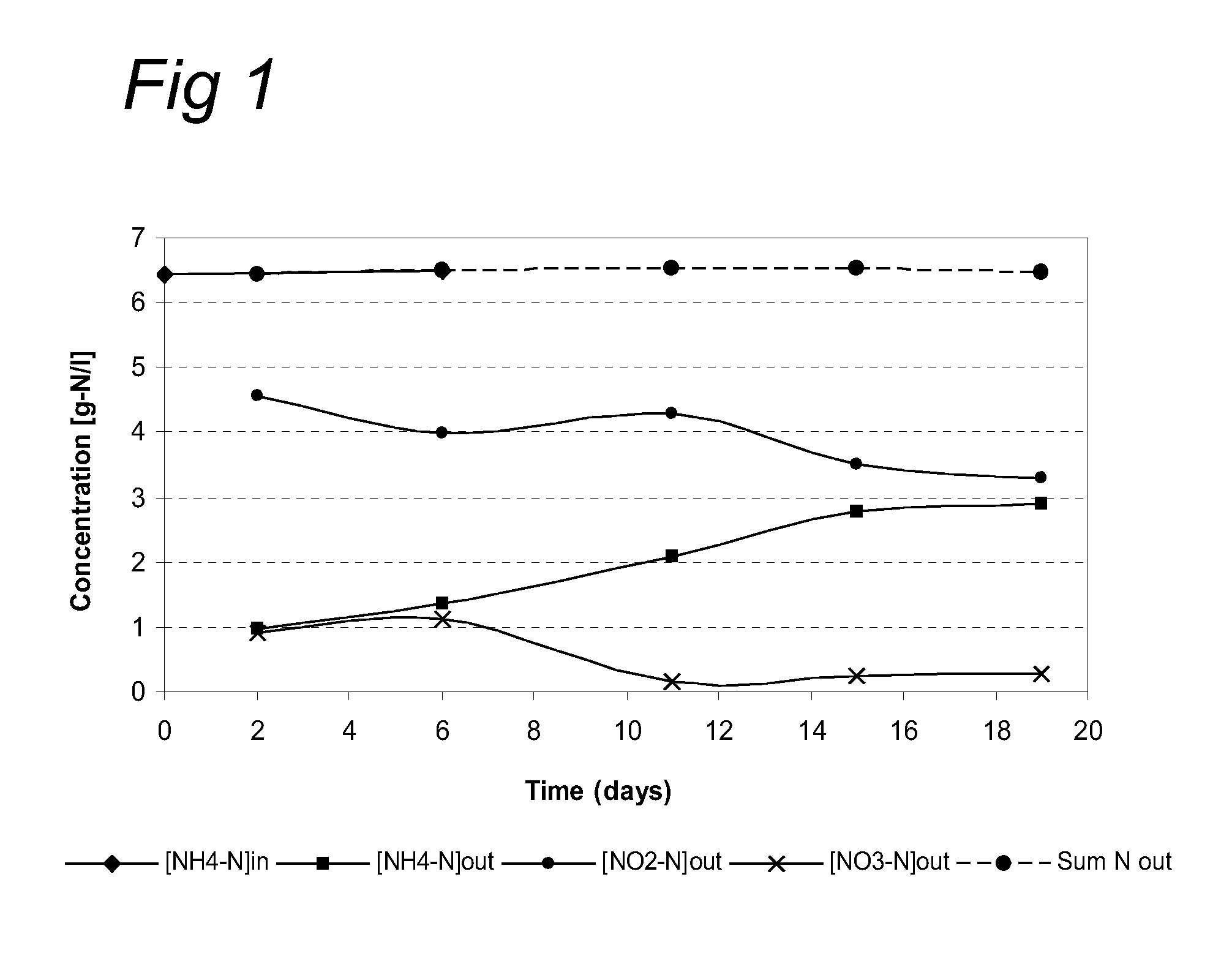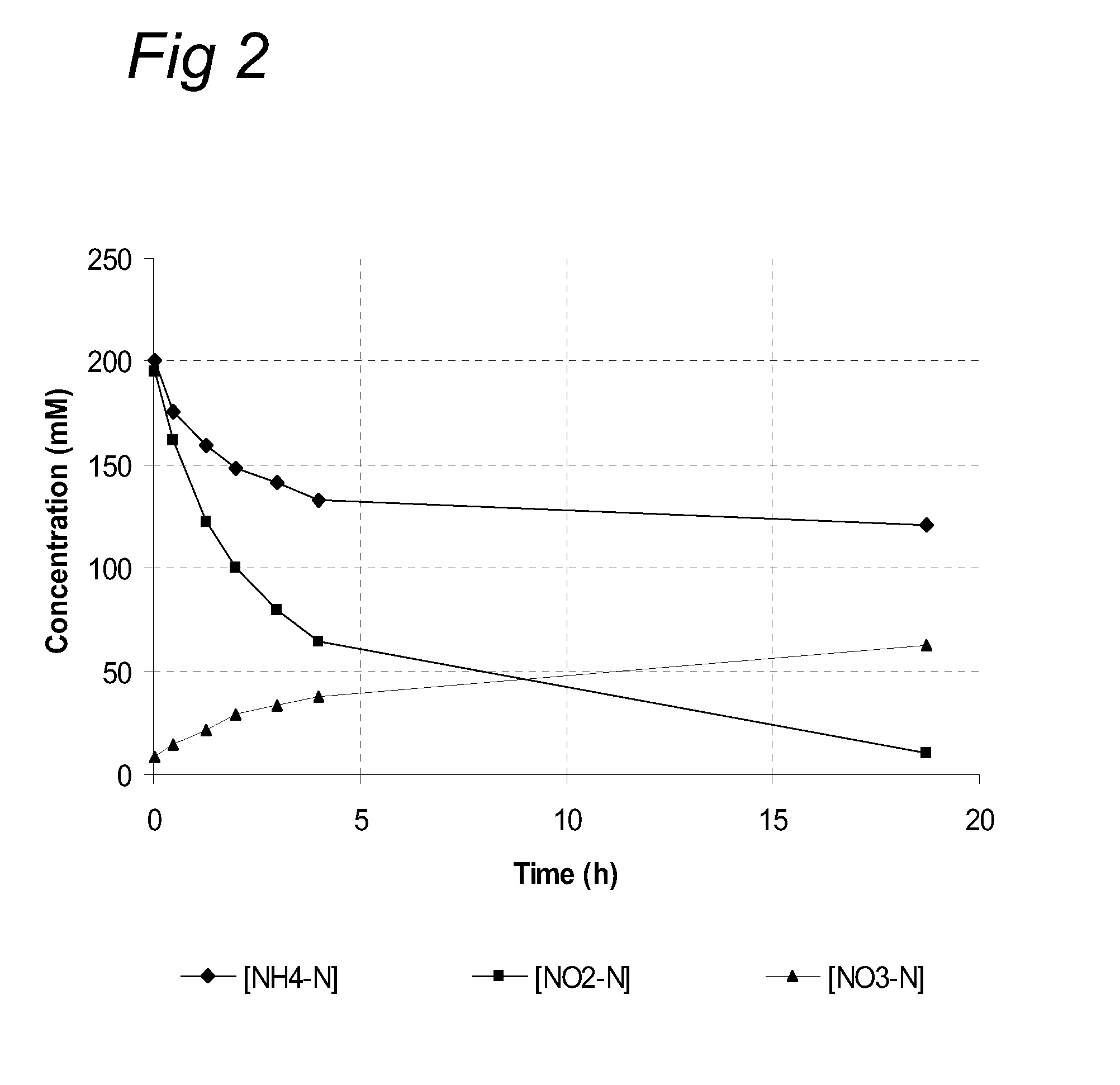Process for the conversion of liquid waste biomass into a fertilizer product
a technology of liquid waste biomass and fertilizer product, which is applied in the direction of gaseous fuel, biochemical equipment, solid fuels, etc., can solve the problems of nutrient and organic matter content, high amount of ammonium nitrogen, phosphorus, etc. being applied to the land, and the time required for digestion of organic wastes is relatively long, so as to achieve the effect of minimizing energy spoilag
- Summary
- Abstract
- Description
- Claims
- Application Information
AI Technical Summary
Benefits of technology
Problems solved by technology
Method used
Image
Examples
example 1
Nitritification Process
[0054]In this example a 2 L continuous flow stirred tank reactor (CSTR) was employed. The influent for the reactor consisted of digested manure, having an ammonium content of 6400 g NH4+—N / m3. The net retention time of the manure was 5 days. The reactor was operated at a temperature of 35° C. During 19 days of operation, the nitrogen contents of the effluent were measured once every 4 or 5 days.
[0055]The results of this nitritification process are shown in FIG. 1, wherein the total effluent nitrogen content, the influent ammonium-nitrogen-content, the effluent ammonium-nitrogen content, the effluent nitrite-nitrogen content and the effluent nitrate-nitrogen content have been plotted against the total reaction time in days.
[0056]As can be seen in said figure, a steady state nitritification process had established after approximately 15 days. From that time on the [NH4+] / [NO2−] ratio in the effluent was about 0.9 and the conversion rate was approximately 700 g N...
example 2
Chemical Oxidation Process
[0057]In this example a 2 L batch reactor was employed, which was fed with nitritified manure from the effluent of the previous example containing 200 mM ammonium nitrite (NH4NO2). The reactor was operated at a temperature of 45° C. The liquid in the reactor was acidified to pH=4.0. The reactor was aerated with a constant flow of 1.5 l / min. of air. During 20 hours of operation, the nitrogen contents of the liquid in the reactor were measured.
[0058]The results of this chemical oxidation process are shown in FIG. 2, wherein the ammonium-nitrogen-content, the nitrite-nitrogen content and the nitrate-nitrogen content have been plotted against the total reaction time in hours.
[0059]As can be seen in said figure ammonium nitrite was converted to ammonium nitrate. The main nitrogen loss was due to the formation of nitrogen gas (N2) as described by the above described reaction (7). Some nitrogen was furthermore lost due to the volatilization of HNO2 and NOx.
example 3
Complete Waste Treatment Process
[0060]One complete exemplary process according to the present invention is described here with reference to the accompanying schematic flow chart shown in FIG. 3. The process starts with the collection of liquid and optionally solid waste biomass which is dumped a cellar. In the dumper cellar the biomass is mixed until the biomass can be pumped to storage tanks. The liquid biomass will be pumped via a stone catcher and grinder to the biomass storage tanks. The storage tanks contain pumps or mixers to mix the biomass or keep the biomass mixed. The storage tanks and the digesters will have a cover. Underneath this cover biogas will accumulate. The storage tanks are connected to a digester via a gas line to each other.
[0061]According to European legislation (1774 / 2002 / EG) the biomass needs to be pasteurised. This is done by heating the biomass to 70° C. for a minimum of 1 hour for class 3 biomass.
[0062]To digest the biomass anaerobic bacteria are needed....
PUM
| Property | Measurement | Unit |
|---|---|---|
| temperature | aaaaa | aaaaa |
| temperature | aaaaa | aaaaa |
| wt % | aaaaa | aaaaa |
Abstract
Description
Claims
Application Information
 Login to View More
Login to View More - R&D
- Intellectual Property
- Life Sciences
- Materials
- Tech Scout
- Unparalleled Data Quality
- Higher Quality Content
- 60% Fewer Hallucinations
Browse by: Latest US Patents, China's latest patents, Technical Efficacy Thesaurus, Application Domain, Technology Topic, Popular Technical Reports.
© 2025 PatSnap. All rights reserved.Legal|Privacy policy|Modern Slavery Act Transparency Statement|Sitemap|About US| Contact US: help@patsnap.com



